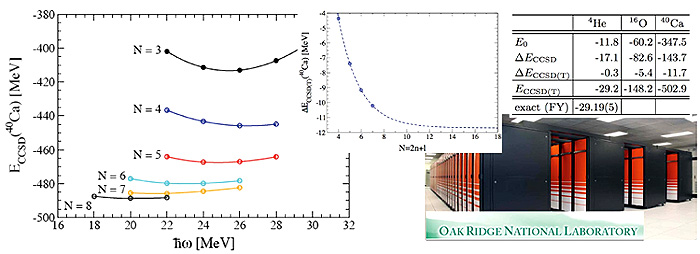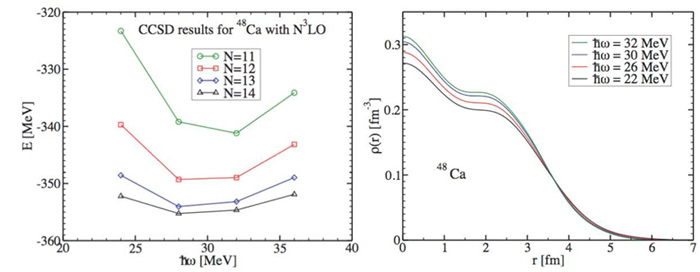
INSTITUTE FOR NUCLEAR THEORY
News
Home | Contact | Search | News archive | Site Map

|
INSTITUTE FOR NUCLEAR THEORY News
Home | Contact | Search | News archive | Site Map |
|||||
Atomic, Chemical, and Nuclear Developments in Coupled Cluster Methods
Today, Coupled Cluster (CC) theory is widely recognized as often offering the most accurate description available for a wealth of important problems in physics and chemistry, ranging from the structure of nuclei, to relativistic CC theory of atoms, to spectra and properties of molecules. The powerful exponential ansatz for the CC wave function, Ψ = exp(T) Φ0, was proposed for nuclear many-body problems by Coester and Kuemmel 50 years ago. T=T1+T2+T3+... corresponds to the sum over particle-hole excitation operators and Φ0 is a mean-field reference state. Detailed equations for the electronic structure of atoms and molecules were presented by Cizek 40 years ago, with initial applications and further developments by Paldus.
In solving directly for the cluster operators, T1, T2,... , CC theory provides a nonperturbative method that extends ab-initio approaches to important many-body systems with on the order of 100 particles. This positions CC theory as key to developing ab-initio density functional theory and a unified description for all nuclei or atoms and molecules. The equations for the cluster operators, truncated at the CCSD[exp(T1+T2)], CCSDT[exp(T1+T2+T3)], or higher level, are always in closed form and lead to size-extensive solutions. In addition, equation-of-motion and Fock space extensions are used to study excitation energies in CC theory.
At the 50th anniversary of CC theory, the INT program brought together nuclear physicists, atomic physicists, and quantum chemists to discuss the current status of CC efforts in these three fields; to identify and discuss new directions that may be of common interest; and to share common experiences in understanding and applying the CC methods to various problems of interest. As part of the program, we organized a three-day symposium on "50 Years of Coupled-Cluster Theory". In attendance celebrating this anniversary were the founders of CC theory: Profs. Hermann Kuemmel, Jiri Cizek, and Joe Paldus; Fritz Coester had planned to attend, but could unfortunately not be present. The program and symposium attracted 50 scientists from 15 countries, and the talks are available on the INT website. This provides a unique set of overviews and state-of-the-art on CC theory for atoms, molecules and nuclei.
CC methods for atoms, molecules and nuclei employ different symmetries and basis functions and have different objectives, but all three fields are connected by the underlying formalism.
In nuclear physics, CC theory connects key frontiers. CC theory tests nuclear forces based on effective field theory and the renormalization group, advances ab-initio methods to medium-mass nuclei, can provide benchmarks for developing a universal density functional from microscopic interactions, and takes advantage of large-scale computing resources. Recent CC highlights in nuclear physics are shown in Figs. 1 and 2. The discussions at the program and the symposium focused on including three-nucleon interactions and studying loosely-bound neutron-rich nuclei in CC theory, on using CC theory to validate nuclear density functional theory (see also the SciDAC UNEDF project), and on ideas to derive non-perturbative shell model interactions using CC methods.
Future CC milestones will be set by the first ab-initio calculation with three-nucleon interactions for medium-mass nuclei, for the Helium and Oxygen chain, by advancing spherical CC theory to heavier nuclei, such as 100Sn and 208Pb, and an ab-initio calculation of the neutron radius of 208Pb.
Recent significant advances in developing coupled-cluster theory have occurred in quantum chemistry. CC methods for ground, excited, closed-shell, and open-shell, non-degenerate and quasi-degenerate states of atoms and molecules and molecular properties have been developed and were discussed in the program and the symposium. In quantum chemistry, CC theory is used to develop an ab-initio density functional theory for electronic systems and there was much interest on these topics. Other main and cross-discipline areas of discussion were applications to open-shell systems, multi-reference CC theory, and alternative approaches for excited states.
The focus of the atomic physics part of the program was on high-precision calculations of energy levels, transition moments, hyperfine constants, and other properties of atoms and ions with high nuclear charge. For neutral systems, high-precision calculations are needed to extract the weak-charge and nuclear anapole moment from experiments on atomic parity nonconservation at a level where significant tests of the Standard Model and theories of weak nuclear forces can be tested. Other important applications include atomic clocks, black-body radiation shifts, and design of optical traps for quantum computer experiments. For highly-charged atoms, precision many-body calculations, when compared with measurements, are used to test strong-field corrections to quantum electrodynamics. From the point of view of chemistry, precise many-body calculations are needed to predict chemical properties of super-heavy elements where direct chemical experiments are not yet possible.
This INT program and symposium attracted many of the researchers who have been instrumental in working with CC theory and related methods for atoms, molecules, and nuclei. By all accounts, the workshop was a great success: The participants found the topics and discussions very useful for their future research. They planted the seeds for many ideas and showed a vibrant field for cross-fertilization between the three areas!
We gratefully acknowledge additional financial support from ORNL and TRIUMF.
(INT program June 23 - July 25, 2008)
Reported by Rod Bartlett, David Dean, Walter Johnson, and Achim Schwenk
Date posted December 2, 2008
![]()

Fig. 1: First ab-initio CC calculations for 4He, 16O and 40Ca based on low-momentum NN interactions. Convergence with number of major shells N+1 included (left figure; N=8 corresponds to a basis dimension of 1063 many-body states), inclusion of triples corrections (middle figure), benchmark results (right table).

Fig. 2: Medium-mass nuclei from chiral effective field theory NN interactions in spherical CC theory.